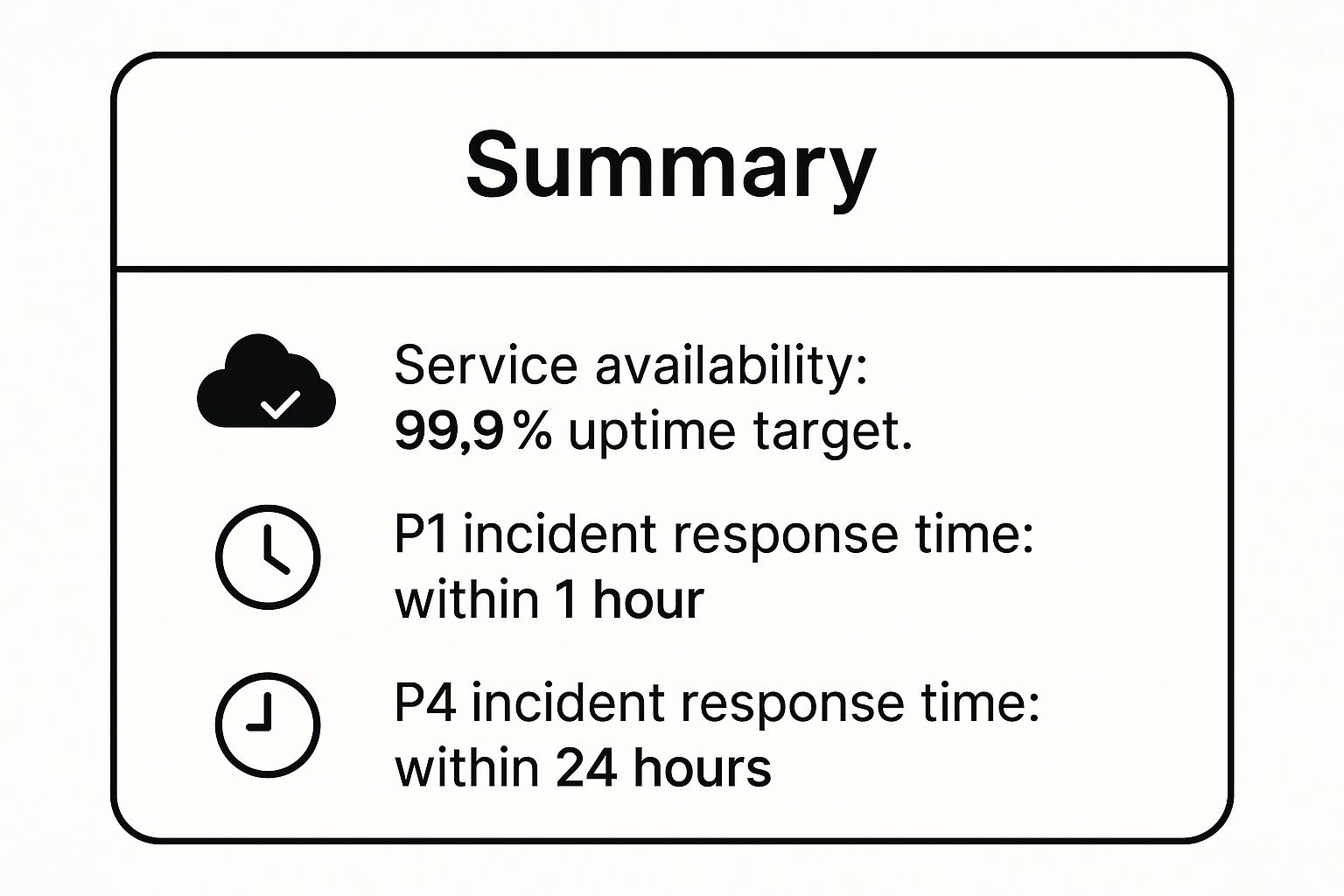Elevate Your Service Delivery with These Pre-Built SLA Templates
Service Level Agreements (SLAs) are crucial for successful service delivery. They establish clear expectations and keep providers and clients aligned. Creating effective SLAs from scratch, however, can be time-consuming. This curated list of six service level agreement templates simplifies the process. These templates cover a range of industries and services, providing a robust foundation for performance benchmarks, responsibilities, and client relationships. This listicle will provide you with:
- Downloadable SLA templates: Ready-to-use templates in various formats (e.g., Word, Google Docs).
- Customization tips: Practical advice on tailoring templates to your specific needs.
- Industry-specific examples: Templates covering IT, cloud services, telecommunications, managed services, business process outsourcing, and SaaS.
- Implementation guidance: Best practices for integrating SLAs into your workflows.
To better understand the practical applications of SLAs, exploring real-world examples can be invaluable. For practical insights, check out these SLA examples. Using a template offers several advantages:
- Saves time and resources: Start with a pre-built framework instead of starting from scratch.
- Reduces ambiguity: Clearly define metrics, responsibilities, and procedures.
- Improves communication: Ensure all stakeholders understand the agreed-upon terms.
- Enhances accountability: Establish clear performance expectations and reporting mechanisms.
This collection helps you quickly implement effective SLAs, whether you're managing IT infrastructure, outsourcing business processes, or providing cloud-based solutions. We'll delve into the specifics of each template, highlighting its strengths and addressing any limitations based on actual usage experience. This practical approach ensures you choose the template that best fits your organization's requirements.
1. ITIL Service Level Agreement Template
The Information Technology Infrastructure Library (ITIL) framework provides a comprehensive approach to IT service management (ITSM). An ITIL-based service level agreement (SLA) template offers a structured way to define, manage, and monitor IT services, ensuring they align with business objectives. It emphasizes service quality, continuous improvement, and clear communication between IT and the business. This template is especially beneficial for organizations seeking a standardized and best-practice approach to service delivery. It's not just a document, but a foundation for a robust ITSM strategy.
Examples of ITIL SLA Implementation
Large organizations, particularly those with complex IT infrastructures, have effectively implemented ITIL-based SLAs. IBM's Global Technology Services uses ITIL principles in structuring its service agreements, ensuring consistent global service delivery. Similarly, Accenture's managed services contracts frequently incorporate ITIL best practices. Even major government IT outsourcing agreements often leverage the ITIL framework to define and manage service expectations. These real-world examples demonstrate the practicality and scalability of ITIL SLAs.
Practical Tips for Using an ITIL SLA Template
Implementing an ITIL SLA requires careful planning and execution. Start by focusing on core ITIL processes like incident, problem, and change management before introducing complex metrics. Ensure your IT team receives adequate ITIL training to understand the framework's principles and apply them effectively. Leverage automated monitoring tools to track SLA performance and generate reports. Finally, establish clear escalation procedures for SLA breaches to ensure swift action and minimize business disruption.
When and Why to Use an ITIL SLA
An ITIL SLA template is particularly valuable when establishing or refining IT services, especially in situations involving multiple stakeholders or complex service dependencies. It’s ideal for:
- Formalizing service expectations between IT and the business.
- Driving continuous improvement through defined metrics and reporting.
- Improving communication and transparency around IT service performance.
- Establishing clear roles and responsibilities for service delivery and support.
This structured approach provides a common language and framework for managing IT services, reducing ambiguity and enhancing collaboration. For organizations in the AE region, particularly those in regulated sectors like healthcare, finance, and logistics, an ITIL-based SLA helps demonstrate compliance and build trust with clients.
The infographic below summarizes some key performance indicators (KPIs) commonly found in an ITIL SLA. These metrics are crucial for tracking service performance and ensuring that the agreed-upon service levels are consistently met.

This quick reference highlights a commitment to high availability (99.9% uptime) and responsiveness, with varying response times based on incident priority (1 hour for P1, 24 hours for P4). The specific metrics chosen will vary based on the nature of the service and business requirements. Understanding these metrics and how they are measured is essential for effective SLA management. For a deeper dive into implementing ITIL-based service management, Learn more about….
This video further illustrates the practical application of ITIL principles in designing and implementing effective service level agreements. By adopting an ITIL-based approach, organizations can move beyond basic service agreements to a more strategic and mature model of IT service delivery. This ensures alignment between IT and business goals, improves service quality, and enhances customer satisfaction.
2. Cloud Service Level Agreement Template
A Cloud Service Level Agreement (SLA) template is specifically designed for cloud computing services. It addresses the unique aspects of cloud environments, including multi-tenancy, scalability, and data security. Covering Infrastructure-as-a-Service (IaaS), Platform-as-a-Service (PaaS), and Software-as-a-Service (SaaS) models, this template provides specific metrics for cloud performance and availability, ensuring a clear understanding of service expectations. This is crucial in the dynamic and often complex world of cloud computing.

Examples of Cloud SLA Implementation
Major cloud providers like Amazon Web Services (AWS), Microsoft Azure, and Google Cloud Platform (GCP) utilize comprehensive SLAs. Their agreements outline performance guarantees for services like compute, storage, and databases. Salesforce, a leading SaaS provider, also uses SLAs to define service availability and performance for its CRM platform. These examples demonstrate the widespread adoption and importance of cloud SLAs in managing service expectations.
Practical Tips for Using a Cloud SLA Template
When using a cloud SLA template, clearly define shared responsibility boundaries between you and the provider. Specify metrics for each cloud service layer (IaaS, PaaS, SaaS). Establish robust data backup and recovery procedures. Consider multi-cloud or hybrid cloud strategies to avoid vendor lock-in and maintain flexibility. These steps are crucial for maximizing the benefits of cloud services while mitigating potential risks.
When and Why to Use a Cloud SLA Template
A cloud SLA template is essential when migrating to or utilizing cloud services. It's particularly valuable when:
- Negotiating service level expectations with cloud providers.
- Ensuring performance and availability of critical business applications.
- Protecting against data loss and downtime.
- Managing costs and optimizing cloud resource utilization.
The template fosters transparency and accountability in the cloud service relationship, promoting a collaborative approach to service management. For organizations in the AE region seeking scalable and reliable cloud solutions, including cloud contact centers, detailed SLAs are paramount. Learn more about…
By using a cloud SLA template, businesses establish a strong foundation for successful cloud adoption, ensuring that their cloud services align with their specific business needs and objectives. This proactive approach to service management promotes trust, enhances communication, and minimizes potential disruptions, contributing to a smoother and more effective cloud journey. Especially in the fast-paced digital landscape of the AE region, a well-defined cloud SLA can provide the necessary structure and security for businesses embracing cloud technologies.
3. Telecommunications Service Level Agreement Template
A Telecommunications Service Level Agreement Template is specifically designed for telecom and network service providers. This template focuses on critical aspects like network performance, connectivity reliability, and the overall quality of communication services. Unlike generic service level agreement templates, it incorporates specific metrics crucial to the telecom industry, such as bandwidth, latency, jitter, and packet loss. It also includes provisions for essential procedures like network maintenance and emergency response. This specialized focus makes it an invaluable tool for managing and monitoring service delivery in the telecommunications sector.

Examples of Telecommunications SLA Implementation
Major telecom carriers like Verizon Business, AT&T, and British Telecom utilize robust SLAs for their network services, demonstrating real-world applications of this template. These agreements often incorporate stringent performance metrics and detailed service level objectives. Network equipment vendors like Cisco and Juniper, when providing managed network services, frequently leverage similar templates in their contracts. This widespread adoption highlights the template's effectiveness in managing complex telecommunications services.
Practical Tips for Using a Telecommunications SLA Template
Implementing a Telecommunications SLA requires a strategic approach. Define clear methodologies and tools for measuring the agreed-upon metrics. Ensure the SLA includes provisions for communicating planned maintenance activities to minimize disruption. Setting realistic targets based on existing network topology is vital. Real-time monitoring and alerting systems are crucial for proactive management and prompt response to service degradations.
When and Why to Use a Telecommunications SLA Template
This specialized template becomes particularly relevant when dealing with critical network infrastructure and communication services. It’s an ideal choice for:
- Ensuring reliable network performance for business operations.
- Managing service expectations between telecom providers and clients.
- Maintaining transparency in service delivery and performance reporting.
- Establishing clear accountability for network availability and quality.
The Telecommunications SLA template offers a structured approach for managing complex service agreements in the telecom industry. It clarifies responsibilities, establishes performance benchmarks, and facilitates effective communication between stakeholders. This proactive approach reduces ambiguity, enhances operational efficiency, and contributes to building stronger client relationships. This is especially crucial in the AE region, where reliable communication infrastructure is vital for business growth and continuity. This type of service level agreement template is popularized by major players in the industry, including large telecom providers like Verizon, AT&T, and BT, as well as network equipment giants like Cisco and Juniper. Industry bodies like the Telecommunications Industry Association (TIA) also contribute to its development and adoption. This collective expertise ensures the template's relevance and effectiveness in managing modern telecommunications services.
4. Managed Services Provider (MSP) SLA Template
A Managed Services Provider (MSP) SLA Template provides a structured framework for defining the services an MSP delivers to its clients. This comprehensive template covers various areas, including help desk support, infrastructure monitoring, security services, and proactive maintenance. It emphasizes outcome-based metrics and customer satisfaction alongside technical performance indicators, ensuring a balanced approach to service delivery. A well-defined MSP SLA is crucial for establishing clear expectations and building a strong, trusting relationship between the MSP and its clients.

Examples of MSP SLA Implementation
Many successful MSPs leverage pre-built or customized SLA templates. Kaseya's MSP platform offers integrated SLA templates that streamline the process of creating and managing service agreements. ConnectWise, another popular MSP platform, provides similar functionality, enabling MSPs to standardize their service delivery and reporting. CompTIA's MSP certification program also emphasizes the importance of SLAs and provides template resources for its members. Reviewing regional MSP provider contracts can also offer valuable insights into practical SLA implementation.
Practical Tips for Using an MSP SLA Template
When using an MSP SLA template, clarity and precision are paramount. Clearly define the service scope and exclusions to avoid ambiguity. Implement robust ticketing and tracking systems to monitor service requests and ensure timely resolution. Establish regular client communication rhythms, providing updates on service performance and addressing any concerns proactively. Use automation to improve response times and ensure consistent service delivery.
When and Why to Use an MSP SLA
An MSP SLA template is essential when outsourcing IT operations and support to a managed service provider. It's particularly beneficial for:
- Establishing clear expectations for service delivery and support.
- Defining performance metrics and reporting mechanisms.
- Protecting both the MSP and the client in case of disputes.
- Facilitating proactive communication and collaboration.
This structured approach fosters transparency and accountability, laying the foundation for a successful MSP-client relationship. For businesses in the AE region, especially those in regulated industries, a well-defined MSP SLA can demonstrate compliance and build trust with stakeholders. This is particularly important in sectors like healthcare, finance, and logistics.
Companies like CompTIA, through their MSP certification programs, strongly advocate for the use of standardized SLA templates. Platforms like Kaseya and ConnectWise, along with channel partner programs from major vendors, have popularized the adoption of these templates, further emphasizing their importance in the managed services industry. By leveraging these resources and best practices, businesses can ensure they receive the expected level of service and support from their chosen MSP. A well-defined SLA contributes significantly to the overall success of the IT outsourcing relationship, enabling businesses to focus on their core competencies while leaving IT management in the hands of experts.
5. Business Process Outsourcing (BPO) SLA Template
A Business Process Outsourcing (BPO) SLA template provides a structured framework for managing the relationship between a business and its BPO provider. It defines the scope of services, performance expectations, and responsibilities of both parties. This specialized template focuses on operational efficiency, quality metrics, and the achievement of specific business outcomes, addressing process-specific requirements like accuracy rates and processing times. This makes it a critical tool for ensuring successful outsourcing arrangements.
Examples of BPO SLA Implementation
Major BPO providers like Accenture, Genpact, Wipro, and Cognizant regularly utilize robust SLAs in their business process services agreements. For example, Accenture uses SLAs to govern its customer service BPO contracts, meticulously outlining performance metrics and escalation procedures. Similarly, Genpact incorporates SLAs into its finance and accounting outsourcing arrangements, emphasizing accuracy rates and compliance adherence. These established practices demonstrate the effectiveness of BPO SLAs in managing complex outsourcing relationships. Furthermore, organizations in the AE region frequently leverage BPO SLAs to streamline operations and maintain high service levels.
Practical Tips for Using a BPO SLA Template
When implementing a BPO SLA, defining clear, measurable quality metrics is paramount. Establish regular governance and review processes to monitor performance against these metrics and identify areas for improvement. Include provisions for knowledge transfer and training to ensure a smooth transition of processes and maintain service continuity. MSPs also need to consider what happens in the event of a data breach. If you need to know how to handle a data breach, read about the proper procedures. Finally, plan for cultural integration and communication protocols to facilitate effective collaboration between your organization and the BPO provider.
When and Why to Use a BPO SLA
A BPO SLA template is essential when outsourcing any business process, from customer service and back-office operations to IT and human resources. It is particularly valuable when:
- Ensuring alignment between business objectives and outsourced processes.
- Managing performance expectations and mitigating risks.
- Establishing clear communication channels and reporting mechanisms.
- Protecting sensitive data and maintaining compliance.
This structured approach fosters transparency, accountability, and a strong working relationship with your BPO provider. Learn more about… Business Process Outsourcing (BPO) SLA Template to gain a comprehensive understanding of this critical aspect of outsourcing. By leveraging a well-defined BPO SLA, organizations can optimize their outsourcing initiatives and achieve desired business outcomes. This is especially important in the AE region, where businesses increasingly rely on BPO providers for competitive advantage.
6. Software-as-a-Service (SaaS) SLA Template
A Software-as-a-Service (SaaS) SLA template provides a structured framework specifically designed for cloud-based applications and platforms. Unlike traditional SLAs, it focuses on metrics crucial to the SaaS model, such as application availability, performance, data security, and user experience. This template incorporates provisions for software updates, feature availability, API performance, and customer support response times, all tailored to the subscription-based nature of SaaS. It ensures both vendors and customers have a clear understanding of service expectations and responsibilities.
Examples of SaaS SLA Implementation
Several prominent SaaS providers offer publicly available SLAs that exemplify best practices. Salesforce's service level commitments outline guaranteed uptime and performance for its CRM platform. Microsoft Office 365's SLA framework details availability targets for various services within the suite. Adobe Creative Cloud's service agreements define performance expectations for its software applications and cloud storage. HubSpot's platform availability guarantees specify uptime and response time commitments. These examples demonstrate how established SaaS companies utilize SLAs to build trust and transparency with their customers.
Practical Tips for Using a SaaS SLA Template
When implementing a SaaS SLA, meticulous attention to detail is crucial. Closely monitor actual performance against the SLA commitments using dedicated monitoring tools. Develop a thorough understanding of the service credit calculation and claim processes. Plan for software update and maintenance windows to minimize disruption. Evaluate integration requirements and API limitations to ensure compatibility with existing systems. These proactive steps will prevent future issues and maintain a positive vendor-customer relationship.
When and Why to Use a SaaS SLA
A SaaS SLA template becomes indispensable when subscribing to any cloud-based application or platform. It’s particularly important when integrating SaaS solutions with critical business processes. Consider a SaaS SLA for:
- Ensuring application availability and performance meet business needs.
- Protecting sensitive data through robust security provisions.
- Defining clear escalation procedures for service disruptions.
- Establishing a framework for managing software updates and maintenance.
This structured approach provides a common understanding between the SaaS provider and the customer, reducing ambiguity and fostering a collaborative partnership. For businesses in the AE region, especially those in regulated sectors, a well-defined SaaS SLA helps demonstrate compliance and manage risk associated with cloud services.
This approach is particularly valuable for organizations reliant on SaaS applications for core business functions. By clearly defining service expectations, a SaaS SLA helps mitigate risks, manage performance, and ensure business continuity. Choosing a provider with a robust and transparent SLA is a critical step in leveraging the benefits of cloud-based software.
SLA Template Comparison Overview
| SLA Template | Core Features / Metrics | User Experience & Quality ★ | Value & Pricing 💰 | Target Audience 👥 | Unique Selling Points ✨ |
|---|---|---|---|---|---|
| ITIL Service Level Agreement | ITIL v4 structure, 99.9% uptime, incident P1-P4 | ★★★★☆ Detailed quality assurance | 💰 Scalable enterprise-ready | 👥 IT service managers, enterprises | 🏆 Industry-standard, continuous improvement |
| Cloud Service Level Agreement | Cloud-specific (elasticity, multi-tenancy), security | ★★★★☆ Modern cloud compliance | 💰 Pay-for-usage, service credits | 👥 Cloud providers, SaaS/IaaS/PaaS users | ✨ Cloud-focused with disaster recovery |
| Telecommunications SLA | Network metrics (bandwidth, latency, jitter) | ★★★★☆ High reliability metrics | 💰 Premium for guaranteed uptime | 👥 Telecoms, network providers | 🏆 Technical precision, QoS guarantees |
| Managed Services Provider SLA | Multi-service support, tiered response times | ★★★★☆ Customer satisfaction focus | 💰 Flexible, outcome-based | 👥 MSPs, IT support teams | ✨ Proactive monitoring, holistic IT coverage |
| Business Process Outsourcing SLA | Process quality, compliance, efficiency | ★★★☆☆ Focus on operational outcomes | 💰 Cost-optimized for business | 👥 BPO firms, enterprises outsourcing | ✨ Tailored for business processes, compliance |
| Software-as-a-Service SLA | App uptime, API performance, updates | ★★★★☆ User experience oriented | 💰 Subscription model, service credits | 👥 SaaS vendors, app providers | ✨ Regular updates, automated credits |
Streamlining Success with the Right Service Level Agreement Template
Selecting the right service level agreement template is paramount for any business, particularly in the AE region where digital transformation and regulatory compliance are key. This article has explored several key templates, each designed for a specific purpose, from ITIL frameworks to cloud services and managed service providers. By understanding the nuances of each, you can make more informed decisions and tailor these templates to your specific organizational needs. This proactive approach sets the stage for stronger client relationships and more streamlined operations.
Key Takeaways for Implementing Effective SLAs
The most valuable takeaway is the understanding that no single service level agreement template fits all. Consider your industry, the specifics of the service being provided, and the unique regulatory landscape of the AE region. Here's a recap of the key considerations:
- Context is Key: Whether you're managing a contact center, deploying cloud telephony, or outsourcing business processes, the right SLA template will reflect the particularities of your operations.
- Customization is Crucial: While pre-built templates offer a solid starting point, customizing them is essential. Adapt the metrics, reporting requirements, and other clauses to accurately represent your agreement with the client or provider.
- Clarity and Communication: An effective SLA is a clear and concise document, easily understood by all parties involved. This clarity fosters accountability and reduces the potential for misunderstandings.
Navigating the Complexities of SLA Management
Implementing service level agreements isn't a one-time task. It requires ongoing monitoring, regular reviews, and adjustments as business needs evolve. For organizations in regulated sectors like healthcare, finance, and logistics, this meticulous approach is even more critical. Maintaining robust SLAs demonstrates a commitment to compliance and helps mitigate potential risks.
This detailed approach to SLA management may seem daunting. However, the benefits far outweigh the initial effort. Well-defined SLAs improve communication, manage expectations, and ultimately contribute to greater business success. They provide a framework for continuous improvement, enabling organizations to optimize their service delivery and strengthen client relationships.
Moving Forward with Confidence
Choosing the right service level agreement template and implementing it effectively is a strategic investment in your business. It's a proactive step toward building stronger relationships, improving service delivery, and achieving sustainable growth. In the dynamic business environment of the AE region, these foundations are essential for success.
Ready to elevate your service management and ensure seamless communication? Cloud Move, a comprehensive cloud-based call center solution, can help you streamline your operations and manage your SLAs efficiently. Visit Cloud Move to learn more about how we can support your business in the AE region.




